Hi all! Michael Gottlieb here. I'm crossposting this article from my website (mzrg.com) at the suggestion of Robert Webb.
I currently have about 550 world records on Minesweeper3D, out of some 660 records above 0 seconds. Here is my attempt to write down as much advice and tips/tricks as I can think of. I made an effort to organize it a bit, but there's not really any particular order within the sections.
Interface
Minesweeper3D has some differences to more standard flat minesweeper games. The most obvious is that you're playing Minesweeper on the surface of an object. This means that as you move around the board, you'll have to rotate the puzzle. This is pretty convenient and smooth. I recommend generally keeping rotations to a minimum (that is, solve what's convenient and visible before rotating the puzzle again), although feel free to use as much rotation as you feel you need to. Good examples are if you're doing logic where you have to look 'around a corner' (not all relevant tiles can be visible at once), or searching the board for unsolved areas.
There are a bunch of camera-related options. I keep Lock Zoom During Game on, both so I can expect a relatively consistent tile size, and to limit the board movements when I'm quickly flagging or chording tiles. (Chording is using the left and right mouse buttons at the same time, or the middle mouse button, to open unsolved tiles. I'll go into this more in depth later.) However, sometimes you do want to change the zoom - a great example is some of the Toroidal boards, where you probably want to be zoomed in much more when solving "interior" tiles as opposed to "exterior" tiles, to keep them at a similar size. In that case I'll briefly turn it off using the menu, change the zoom, and turn it back on. Of course, I try to keep this to a minimum while solving.
There is also a Mouse Interia option. You can have this turned on during a game, but I recommend against it - you never want to have things moving around when you're not deliberately moving them.
You can also Store and Retrieve up to 10 camera positions at once. I haven't used this much, but it can be useful to keep track of a few areas you can't solve and will have to come back to later. You can then switch between them very quickly with the 0-9 keys and avoid trying to find them by looking around the puzzle.
You should generally have ? Marks off. Like in standard minesweeper, they tend to just get in the way, they don't really stand out much. There may be some puzzles where this is useful, as a way to mark pairs of tiles where one of the two tiles contains a mine but you know there can't be a way to tell which is which; this would avoid wasting time later making the same deduction (that you can't figure out which tile has the mine) over and over again.
I also always have sound off. Maybe it's fun for a little bit, but I much prefer listening to other things while playing.
There are a bunch of statistics things you can make visible under the Options menu. "Stats" is useful on small boards which you will be completing many times, to give you a quick reference for the time to beat. I find in larger boards it's nice to jog your memory but during the solve it just gets in the way (although thankfully it doesn't affect clicking at all, it's just graphical). The Mines Countdown is useful to see your progress, especially on large boards - I also look at the Mines Left counter on the top-left, but mainly at the end where the exact number is an important signal. Sometimes I'll also have the World Record Countdown to give me a sense of whether I'm going fast enough to beat the record. I never use the Personal Best Countdown, but then again I'm going for world records anyway, so my local best is just a statistic rather than a useful target.
Auto-solving is a pretty cool feature, but not really relevant to me when solving. It does have a feature to show you the probabilities of the next tiles, but if I'm doing a solve and I get totally stuck, I'll typically just guess, and if I guess wrong it's too late anyway.
If you're moving around a lot, or if the puzzle's at an angle where some pieces have a lot of light on them, it can sometimes be hard to read the numbers. So at least for small numbers, since those are the most common, I recommend getting used to reading them by color. That is, you always know blue is 1, green is 2, red is 3. So even if the contrast is low, or you bring a huge field of numbers into view, you can quickly tell what each number is.
One unfortunate bug I've found is that if you click between tiles you can occasionally click "through" the puzzle - that is, none of the obvious tiles will recognize the click, but another tile that's at the same place on the screen but behind the visible tiles (that is, usually on the back of the puzzle) will take the click instead. Often this will do nothing. If it's a left click, this might kill the current game. If it's a chord (left+right buttons or middle button) it might open a few tiles, but will be safe unless you've flagged something incorrectly. If it's a right click, it might mark a flag somewhere else on the puzzle, which can actually come up later in a couple ways: (a) you might notice it among a field of unsolved tiles, in which case you should just remove the flag; (b) it might flag a tile that you then do an opening around (that's when you trigger lots of tiles automatically when you open a tile with no mines near it), which means you'll end up with a flag with no numbers next to it, and although this can be hard to notice, if you do see it you can treat it like type a; (c) it might just remove a flag you've already placed, in which case it either wastes a tiny amount of time or causes an unflagged tile you may need to search for at the very end of the puzzle when you're trying to flag everything; or, (d) if you're really unlucky, the flag will be incorrect and also near a bunch of tiles you're currently solving, which means unless you're very careful, there's a good chance you'll chord near it later and blow up a mine. As far as I can tell this bug does not show up for everyone (since the dev says he can't replicate it), but it does for me. If it does for you as well, my advice is to just try to be a bit more careful with clicking, but accept that it will happen from time to time, and that the type d situation is pretty unlikely, so it's best to not worry about it and just handle the other types if you notice them.
Notes on Minesweeper3D
-
Michael Gottlieb
- Posts: 6
- Joined: Sun Sep 23, 2018 6:17 pm
Re: Notes on Minesweeper3D
Geometries
Each board has different geometry, of course - that's what makes them different boards. But as you increase the number of subdivisions per face, the geometry you are solving relies more and more on the way each face gets subdivided. Tiles next to an edge feel similar to tiles in the middle of a face, just wrapped around an edge - although it can be tricky if the two faces are divided up in different ways. The corners are the most custom, again depending on the board. So, on larger subdivisions, the corners of the faces of the polyhedron are the places where you will want to be a little more cautious.
There are three basic geometries faces can have: triangular, square, and pentagonal. Pentagonal geometries will show up when any face with at least five edges is subdivided, because the middle tile in the face will have as many sides as the original face, but the rest will be pentagons. The square geometry, on square faces, is pretty much the same as you'll see in any standard minesweeper game, so if you're experienced in minesweeper that will be the most familiar and easy to deal with. Triangular geometry shows up on triangular faces.
Pentagonal geometry is unusual, but not too hard to deal with. Every vertex will have either 3 or 4 tiles around it, and every tile will be next to 5, 7, or 8 tiles (I think). However, this geometry isn't regular, which means that you'll have to pay attention to how pieces are connected locally. Pieces are connected in a simpler way compared to square geometry, which means that nontrivial logic (not anything like 'the unknown tiles around this number are either all safe or all mines') is less likely to help solve more tiles. So if you are solving an area with this geometry, it will generally either go pretty fast, as long as it's possible to move forward.
Triangular geometry is more difficult and will require more practice. There are 6 tiles around each vertex and every tile will be next to 12 tiles. Pieces are connected in a pretty different way than squares, and the numbers are often larger than what you'd see in squares. There is also a lot of nontrivial logic, which makes it a lot harder to solve this geometry. However, it's fortunate that a field of triangles is very regular, unlike pentagonal geometry, so you don't really have to react to the geometry, just the clues. The good news is that the extra information from the tiles being so tightly connected means it's less likely you will get stuck during a solve.
Especially for high levels of subdivision, it can be pretty helpful to look at puzzles by their face geometry as I mentioned above. Some puzzles have just triangles, just squares, or just pentagons; others have a mix of two or three of those types. You will probably have some type that you are relatively strong at, so you'll find it easier to get records (or at least get closer to them) when doing puzzles of that type. When I started, due to years of experience in regular minesweeper, I found squares easiest by far, but over time I've gotten used to the other types as well.
As far as the large-scale geometry, the game divides boards up into six types, which really boil down into three: Convex, Nonconvex, and Toroidal. Convex boards are roughly ball-shaped and don't involve anything special, just looking at how the faces are connected. In addition, convex boards can never have a huge number of tiles at a given vertex, and I think always will have 6 or fewer. So this means more familiar logic.
Nonconvex boards have some raised areas and some sunken areas. A lot of these have spikes of some kind, and others are a simpler complex shape with some areas sunken into the puzzle. One complexity with this is that it can mean some areas with a lot of tiles around one vertex, sometimes as many as ten. This is difficult because a lot of tiles will be next to all of those tiles, meaning they can't give much information about those tiles and you will often have to work around that vertex to solve the area. There can also be some issues getting a good camera angle, because the angle of the faces around a given vertex (or even an edge) can vary a lot, meaning you can never really get a good viewing angle of all of them at once. And further than viewing angle, if a face is at too oblique of an angle you can't reliably click on one of the tiles, so you may have to shift the camera a lot to safely click everywhere you need to. I'll go more into detail on some of the particularly tricky ones in the Level-Specific section, but essentially, nonconvex puzzles are just more awkward to solve than convex ones.
Toroidal boards are objects that have at least one hole in them. These vary a lot in difficulty/awkwardness, with some of the problems of the nonconvex boards (a toroidal board can't be convex everywhere) and some of their own problems. There aren't vertices with tons of tiles around them, but there are vertices where it's impossible to get a good view of all the relevant tiles at once, which makes it very hard to apply logic near them. Also, some of these boards are cage-like and essentially have an inside and an outside; tiles on the inside can sometimes only be conveniently viewed through one of the 'windows' of the cage. Inside tiles will also necessarily be further away from the camera so you'll want to zoom in further than you would for solving outside tiles. In the cagelike puzzles, you can often do some of the tiles lining the windows without looking through the middle of the puzzle, but to do this comfortably and get the tile as flat as possible relative to the camera, you will want to hold the puzzle so the window is pointing to the right/left and the desired tile is near the right/left of the screen. Doing this while having the tile show up zoomed in enough may require making the game window wider than it is tall.
Each board has different geometry, of course - that's what makes them different boards. But as you increase the number of subdivisions per face, the geometry you are solving relies more and more on the way each face gets subdivided. Tiles next to an edge feel similar to tiles in the middle of a face, just wrapped around an edge - although it can be tricky if the two faces are divided up in different ways. The corners are the most custom, again depending on the board. So, on larger subdivisions, the corners of the faces of the polyhedron are the places where you will want to be a little more cautious.
There are three basic geometries faces can have: triangular, square, and pentagonal. Pentagonal geometries will show up when any face with at least five edges is subdivided, because the middle tile in the face will have as many sides as the original face, but the rest will be pentagons. The square geometry, on square faces, is pretty much the same as you'll see in any standard minesweeper game, so if you're experienced in minesweeper that will be the most familiar and easy to deal with. Triangular geometry shows up on triangular faces.
Pentagonal geometry is unusual, but not too hard to deal with. Every vertex will have either 3 or 4 tiles around it, and every tile will be next to 5, 7, or 8 tiles (I think). However, this geometry isn't regular, which means that you'll have to pay attention to how pieces are connected locally. Pieces are connected in a simpler way compared to square geometry, which means that nontrivial logic (not anything like 'the unknown tiles around this number are either all safe or all mines') is less likely to help solve more tiles. So if you are solving an area with this geometry, it will generally either go pretty fast, as long as it's possible to move forward.
Triangular geometry is more difficult and will require more practice. There are 6 tiles around each vertex and every tile will be next to 12 tiles. Pieces are connected in a pretty different way than squares, and the numbers are often larger than what you'd see in squares. There is also a lot of nontrivial logic, which makes it a lot harder to solve this geometry. However, it's fortunate that a field of triangles is very regular, unlike pentagonal geometry, so you don't really have to react to the geometry, just the clues. The good news is that the extra information from the tiles being so tightly connected means it's less likely you will get stuck during a solve.
Especially for high levels of subdivision, it can be pretty helpful to look at puzzles by their face geometry as I mentioned above. Some puzzles have just triangles, just squares, or just pentagons; others have a mix of two or three of those types. You will probably have some type that you are relatively strong at, so you'll find it easier to get records (or at least get closer to them) when doing puzzles of that type. When I started, due to years of experience in regular minesweeper, I found squares easiest by far, but over time I've gotten used to the other types as well.
As far as the large-scale geometry, the game divides boards up into six types, which really boil down into three: Convex, Nonconvex, and Toroidal. Convex boards are roughly ball-shaped and don't involve anything special, just looking at how the faces are connected. In addition, convex boards can never have a huge number of tiles at a given vertex, and I think always will have 6 or fewer. So this means more familiar logic.
Nonconvex boards have some raised areas and some sunken areas. A lot of these have spikes of some kind, and others are a simpler complex shape with some areas sunken into the puzzle. One complexity with this is that it can mean some areas with a lot of tiles around one vertex, sometimes as many as ten. This is difficult because a lot of tiles will be next to all of those tiles, meaning they can't give much information about those tiles and you will often have to work around that vertex to solve the area. There can also be some issues getting a good camera angle, because the angle of the faces around a given vertex (or even an edge) can vary a lot, meaning you can never really get a good viewing angle of all of them at once. And further than viewing angle, if a face is at too oblique of an angle you can't reliably click on one of the tiles, so you may have to shift the camera a lot to safely click everywhere you need to. I'll go more into detail on some of the particularly tricky ones in the Level-Specific section, but essentially, nonconvex puzzles are just more awkward to solve than convex ones.
Toroidal boards are objects that have at least one hole in them. These vary a lot in difficulty/awkwardness, with some of the problems of the nonconvex boards (a toroidal board can't be convex everywhere) and some of their own problems. There aren't vertices with tons of tiles around them, but there are vertices where it's impossible to get a good view of all the relevant tiles at once, which makes it very hard to apply logic near them. Also, some of these boards are cage-like and essentially have an inside and an outside; tiles on the inside can sometimes only be conveniently viewed through one of the 'windows' of the cage. Inside tiles will also necessarily be further away from the camera so you'll want to zoom in further than you would for solving outside tiles. In the cagelike puzzles, you can often do some of the tiles lining the windows without looking through the middle of the puzzle, but to do this comfortably and get the tile as flat as possible relative to the camera, you will want to hold the puzzle so the window is pointing to the right/left and the desired tile is near the right/left of the screen. Doing this while having the tile show up zoomed in enough may require making the game window wider than it is tall.
-
Michael Gottlieb
- Posts: 6
- Joined: Sun Sep 23, 2018 6:17 pm
Re: Notes on Minesweeper3D
Density and Puzzle Size
There are four density options: 10% (Beginner), 15% (Intermediate), 20% (Expert), and 25% (Insane!). For reference, the intermediate board in regular Minesweeper (16x16 with 40 mines) has 15.625% density, and the expert board in regular Minesweeper (16x30 with 99 mines) has 20.625% density, so that should give a sense of how dense those are. You can also choose custom density, but I don't really see the point especially with so many board-subdivision-density combinations to play.
Clearly a higher density is more difficult to finish, but they do feel different depending on the geometry of the board. At a given density, you'll see more or bigger open areas the fewer tiles each tile is next to. But the more tiles each tile is next to, the less likely you are to get stuck and be unable to solve an area - it takes more mines around an area to prevent you from having enough information to enter that area safely. So on very large boards, for instance, you might be able to solve 20% density on a mostly-triangular board without much or any guessing, but on a mostly-pentagonal board that same 20% might be almost impossible.
The actual size of puzzles, in terms of number of tiles, varies a lot based on the board. You can see the number of tiles on the top left of the game without needing to start playing a particular board. For the biggest subdivision level, the smallest puzzle is Tetrahedron with just 256 tiles, and the largest is Zeolite with 21,184; most puzzles are a few thousand tiles. Of course, a small or medium puzzle on subdivision 8 will be as big as a huge puzzle on a lower subdivision.
For each step of subdivision (from 1 to 2 to 4 to 8 ), faces with triangular or square geometry will have 4 times the number of tiles. Faces with pentagonal geometry will have at least 6 times, or slightly more the more tiles the original face had. So a triangular or square tile on subdivision 1 will have 64 tiles on subdivision 8, whereas a pentagonal tile will have 216 and larger tiles will have even more (a 12-sided tile, the largest in the game, will have 517).This means that for puzzles at a high subdivision the faces with the most sides in the basic board will have the most influence on how the puzzle feels to solve.
Playing Methods
There are three basic ways of playing through a board, like in regular minesweeper: flagging nothing, flagging when necessary, and flagging everything. The one you should use depends on the density and board size, but for most boards, you'll just want to flag everything. I'll go over that first.
It costs time to click on all the mines, but it's easier to tell when you're done with an area of the board, and it's also way safer. Flagging all the mines means that you can rely on chording (pressing the left and right mouse buttons together, or the middle button) to open most of the tiles, and the only way chording can cause you to hit a mine is if you incorrectly have a flag on a safe tile.
Another big benefit of flagging everything is what happens when a board is almost completed. Sometimes you'll finish all the obvious areas and immediately win the game, and that's great. But other times, you'll open pretty much everything, but the board isn't completed yet. Now, in Minesweeper3D, unlike other minesweeper games, it's actually possible to beat a board either by opening all safe tiles OR by correctly flagging all mines. So if you think you've flagged all the mines, then what's remaining must include some unopened safe tiles and some unflagged mines. The nice thing is that if you search around the board at this point, any tile without a flag means you have work to do there. If you haven't been flagging everything, and you are almost finished with a board, it can be a lot harder to tell what's left to do.
There is an interesting side effect of being able to finish by correctly flagging all mines. If there are small sections that it's impossible to solve logically, it's still possible to finish the board without guessing (and thus without running the chance of blowing up a mine) by trying every possible mine combination with the correct number of mines. If you're going to do this, it's obviously important to solve as much of the board as possible, and ideally you want fewer than 10 mines left, so if there are large unsolvable areas you should still guess to try to make them smaller. It's also necessary to flag every mine outside of the impossible areas, or else the strategy won't work. (If you do try every mine combination and the board doesn't complete, it usually means there is a flag missing somewhere else on the board.) This is also a situation where storing camera positions can help by removing the need to search for the unsolved areas while trying possibilities. Again, if you haven't been flagging everything and you run into an unsolvable area, your only choices are to either take a guess, or flag every remaining mine so you can do the above technique.
As for the other two ways of playing - no flagging is exactly what it sounds like, flagging nothing at all. Flagging when necessary, or minimal flagging, is basically no-flagging except that you sometimes flag a mine or two so that you can chord to open multiple tiles at once, saving you clicks and time. These strategies have their place and can deliver very fast times if you can follow them quickly. These can both only be done if you're comfortable with the logic, and if the board isn't too difficult. The benefit is that by not flagging everything, you can use far fewer clicks, so if the strategy doesn't add too much additional thinking time it can be very fast. Minimal flagging is more efficient if done properly, but is also more to keep track of (you're thinking both about where the mines are and where you can flag to be efficient) and adds a little visual clutter (some tiles will have a flag and some won't, arbitrarily). Also, if you tend to use the mines countdown to see how far you are through a board, with these strategies it won't help you at all.
I'd mainly use these two strategies for either low-density boards (pretty much 10% only) or small and fast boards (under 10-15 seconds), although I've done non-flagging completions on a few square-geometry only boards, just because I'm so used to non-flagging in standard minesweeper. If you do use these strategies, you will have to hope that there aren't unopened safe tiles at the end, or at least not ones you can't find quickly. But it's usually easy to find safe tiles on a very low-density board, simply by looking for areas with a lot of tiles in one place. For small and fast boards, you're going to be hoping for an unusually fast game anyway, so if you have a board that you think should be finished but isn't, you might as well guess. If you have to carefully look around the board, that game or mine layout probably isn't good enough anyway.
There are four density options: 10% (Beginner), 15% (Intermediate), 20% (Expert), and 25% (Insane!). For reference, the intermediate board in regular Minesweeper (16x16 with 40 mines) has 15.625% density, and the expert board in regular Minesweeper (16x30 with 99 mines) has 20.625% density, so that should give a sense of how dense those are. You can also choose custom density, but I don't really see the point especially with so many board-subdivision-density combinations to play.
Clearly a higher density is more difficult to finish, but they do feel different depending on the geometry of the board. At a given density, you'll see more or bigger open areas the fewer tiles each tile is next to. But the more tiles each tile is next to, the less likely you are to get stuck and be unable to solve an area - it takes more mines around an area to prevent you from having enough information to enter that area safely. So on very large boards, for instance, you might be able to solve 20% density on a mostly-triangular board without much or any guessing, but on a mostly-pentagonal board that same 20% might be almost impossible.
The actual size of puzzles, in terms of number of tiles, varies a lot based on the board. You can see the number of tiles on the top left of the game without needing to start playing a particular board. For the biggest subdivision level, the smallest puzzle is Tetrahedron with just 256 tiles, and the largest is Zeolite with 21,184; most puzzles are a few thousand tiles. Of course, a small or medium puzzle on subdivision 8 will be as big as a huge puzzle on a lower subdivision.
For each step of subdivision (from 1 to 2 to 4 to 8 ), faces with triangular or square geometry will have 4 times the number of tiles. Faces with pentagonal geometry will have at least 6 times, or slightly more the more tiles the original face had. So a triangular or square tile on subdivision 1 will have 64 tiles on subdivision 8, whereas a pentagonal tile will have 216 and larger tiles will have even more (a 12-sided tile, the largest in the game, will have 517).This means that for puzzles at a high subdivision the faces with the most sides in the basic board will have the most influence on how the puzzle feels to solve.
Playing Methods
There are three basic ways of playing through a board, like in regular minesweeper: flagging nothing, flagging when necessary, and flagging everything. The one you should use depends on the density and board size, but for most boards, you'll just want to flag everything. I'll go over that first.
It costs time to click on all the mines, but it's easier to tell when you're done with an area of the board, and it's also way safer. Flagging all the mines means that you can rely on chording (pressing the left and right mouse buttons together, or the middle button) to open most of the tiles, and the only way chording can cause you to hit a mine is if you incorrectly have a flag on a safe tile.
Another big benefit of flagging everything is what happens when a board is almost completed. Sometimes you'll finish all the obvious areas and immediately win the game, and that's great. But other times, you'll open pretty much everything, but the board isn't completed yet. Now, in Minesweeper3D, unlike other minesweeper games, it's actually possible to beat a board either by opening all safe tiles OR by correctly flagging all mines. So if you think you've flagged all the mines, then what's remaining must include some unopened safe tiles and some unflagged mines. The nice thing is that if you search around the board at this point, any tile without a flag means you have work to do there. If you haven't been flagging everything, and you are almost finished with a board, it can be a lot harder to tell what's left to do.
There is an interesting side effect of being able to finish by correctly flagging all mines. If there are small sections that it's impossible to solve logically, it's still possible to finish the board without guessing (and thus without running the chance of blowing up a mine) by trying every possible mine combination with the correct number of mines. If you're going to do this, it's obviously important to solve as much of the board as possible, and ideally you want fewer than 10 mines left, so if there are large unsolvable areas you should still guess to try to make them smaller. It's also necessary to flag every mine outside of the impossible areas, or else the strategy won't work. (If you do try every mine combination and the board doesn't complete, it usually means there is a flag missing somewhere else on the board.) This is also a situation where storing camera positions can help by removing the need to search for the unsolved areas while trying possibilities. Again, if you haven't been flagging everything and you run into an unsolvable area, your only choices are to either take a guess, or flag every remaining mine so you can do the above technique.
As for the other two ways of playing - no flagging is exactly what it sounds like, flagging nothing at all. Flagging when necessary, or minimal flagging, is basically no-flagging except that you sometimes flag a mine or two so that you can chord to open multiple tiles at once, saving you clicks and time. These strategies have their place and can deliver very fast times if you can follow them quickly. These can both only be done if you're comfortable with the logic, and if the board isn't too difficult. The benefit is that by not flagging everything, you can use far fewer clicks, so if the strategy doesn't add too much additional thinking time it can be very fast. Minimal flagging is more efficient if done properly, but is also more to keep track of (you're thinking both about where the mines are and where you can flag to be efficient) and adds a little visual clutter (some tiles will have a flag and some won't, arbitrarily). Also, if you tend to use the mines countdown to see how far you are through a board, with these strategies it won't help you at all.
I'd mainly use these two strategies for either low-density boards (pretty much 10% only) or small and fast boards (under 10-15 seconds), although I've done non-flagging completions on a few square-geometry only boards, just because I'm so used to non-flagging in standard minesweeper. If you do use these strategies, you will have to hope that there aren't unopened safe tiles at the end, or at least not ones you can't find quickly. But it's usually easy to find safe tiles on a very low-density board, simply by looking for areas with a lot of tiles in one place. For small and fast boards, you're going to be hoping for an unusually fast game anyway, so if you have a board that you think should be finished but isn't, you might as well guess. If you have to carefully look around the board, that game or mine layout probably isn't good enough anyway.
-
Michael Gottlieb
- Posts: 6
- Joined: Sun Sep 23, 2018 6:17 pm
Re: Notes on Minesweeper3D
Logic
Most of the logic here is pretty basic logic, like you'll find in regular minesweeper. And while solving, most of the time, you'll be using that logic. I'm going to cover that but also show some special cases that you don't really see in flat, square minesweeper games.
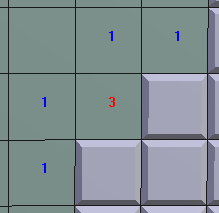
The most basic logic is when a number is surrounded by exactly the number of tiles as the number of mines, like above, a 3 with 3 tiles next to it. In this case, you can flag them all. And if a number already has that number of flagged tiles around it, you can open any other tiles next to it, usually by chording (pressing the left + right mouse button together, or the middle mouse button). This alone will get you through most of the lowest-density boards. This is extremely easy to apply, so the hardest part is actually identifying which tiles you can do this on - you may need to count to see if a 6 is actually next to six or seven tiles, for example.
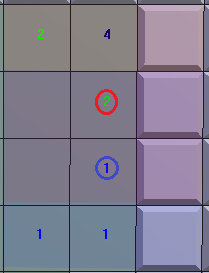

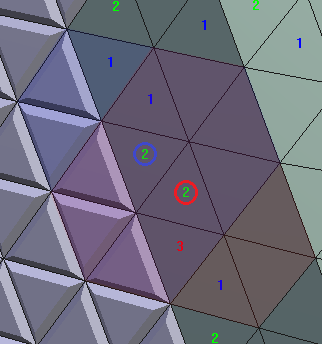
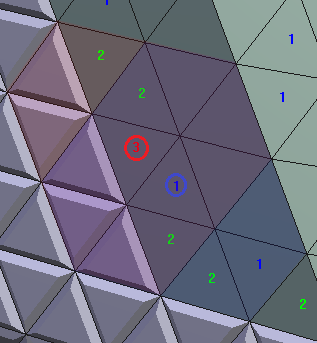
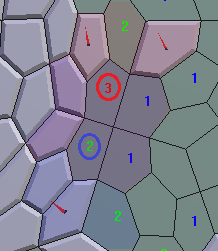
The next type of logic is the most important: comparing two numbers. Each of the above pictures shows one way this can show up. You have a number with a red circle, and a number with a blue circle; the red area is next to the red number, the blue area is next to the blue number, and the purple area is next to both. Now, ignore the purple area; the difference between the two numbers is equal to the difference in the number of mines in the two non-purple areas! So let's take the square with a circled 1 and 4. The blue number is 3 more than the red number, so that means the blue shaded area has 3 more mines than the red shaded area, which in that case means all three of the blue tiles are mines and the one unknown red tile is safe.
Although this just gives you the difference in two areas, it's pretty common that this will show all unknown tiles in one of the areas must be safe, or all must have mines. It's also common to find out that, say, red has two more mines than blue, but blue has one marked mine already along with some unknown squares, and red only has 3 tiles, so red must have 3 mines (they are all mines) and blue must have 1 (the unknown ones are safe). There are tons of places where this logic comes in handy and can solve a tile or two, especially in a triangular geometry where you will be using this constantly on higher densities. By the way, the purple area (next to both numbers) will almost always contain at least two tiles. This isn't required, but it turns out that if the purple area contains one tile or fewer, any deduction you can make using this type of logic can also be made with just basic logic.
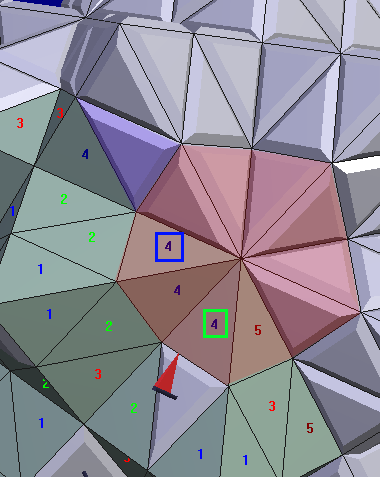
This is minor but is actually a special case of comparing two clues. Look at that vertex with a whole 10 tiles next to it; all those tiles are adjacent to each other. I've marked those with red. That means a number in any tile in the red area will include in its count the number of mines in the red area - the number of red mines, plus the number of mines outside the red that it's adjacent to. Looking at the 4 with the green rectangle, it clearly is next to 1 mine outside the red (and 3 mines inside the red, but you can forget about that). Now the 4 in the blue rectangle is also in the red area, which means it's also adjacent to 1 mine outside the area, which must be in the tile I marked blue. The numbers don't have to be the same, either: a 5 in the red area is next to 2 mines outside it, a 3 in the red area is next to 0 mines outside it, and so on. So the 5 in the red area is adjacent to two mines outside the red area, so one of the two tiles in the bottom right of the picture is a mine. This saves time by letting you ignore the whole area next to the big vertex, giving you much less to reason about, like a mental shortcut. You can solve a lot of things around a big vertex by applying this logic over and over, too. And of course this is extra useful when you know that some number must be adjacent to no mines outside the vertex's area - the rest of the tiles next to that number are all safe.
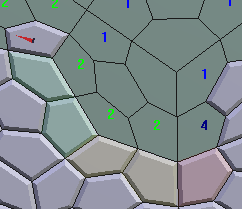
This isn't a separate type of logic, but rather a technique you can use to sort of chain small deductions together until they become useful. This seems to be useful more often on pentagonal-geometry puzzles, on the boundary between solved and unsolved areas. In the picture, the leftmost 2 tells you the green area has 1 mine, then the next 2 tells you the yellow area has one mine (green and yellow together have two), then the next 2 tells you the red area has one mine (yellow and red together have two), so you can place a flag on red. Don't look out for this specific case, but if you notice an area of say two tiles with one mine or three tiles with one or two mines, check around to see if that can help you deduce something more useful.
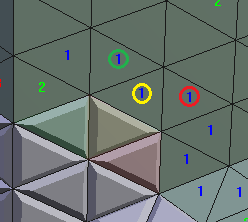
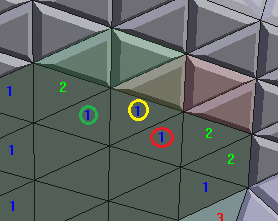
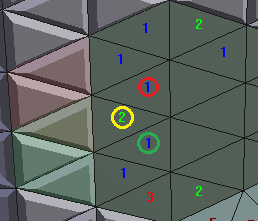
These are a few shortcuts I've noticed when solving triangular-geometry areas, where a slightly complex pattern pops up a lot, and you can save time by treating it as a single pattern instead of applying the logic. The first one shows a sort of corner jutting out from an area of unsolved tiles, and you have three clues: green adjacent to the green and yellow tiles, red adjacent to the yellow and red tiles, and yellow adjacent to all three. If they're all 1s, like in the picture, the yellow tile is always a mine and the other two are safe. Or, if the yellow is a 2 and the green and red are 1s, the yellow is always safe and the other two are mines.
Similarly, there is some logic you can apply to a flat wall of tiles. You again have a green clue adjacent to green and yellow tiles, a red clue adjacent to yellow and red tiles, and a yellow clue adjacent to all of them. If they are all 1, like the corner, the yellow tile must be a mine. Or, if green/yellow/red are 1/2/1 respectively, then the yellow tile is safe (although this time all you know about the green and red areas is that they contain 1 mine each). There are a couple of other nontrivial similar patterns: if green/yellow/red are 1/2/2 or 2/2/1 or 2/3/2, then the yellow tile is a mine; if they are 1/3/2 or 2/3/1 or 2/4/2, then the yellow tile is safe. Just be careful to check that the green, yellow, and red marked clues are actually only next to those 5 unsolved tiles.
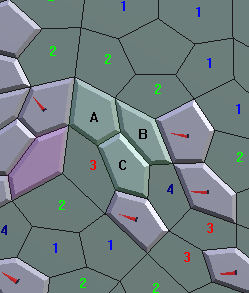
Finally, this is an unusual kind of logic based on an odd number of tiles in a sort of ring arrangement. In the picture there are 3, but 5 is pretty common as well, and maybe bigger odd numbers could show up. In the picture there are 3 green tiles labeled A, B, and C, and notice that the existing clues tell us there is a mine in A or B, and a mine in B or C. Since those pairs of cells have exactly one mine you can't use basic logic. But when you look at the pair that "completes the ring", A and C, you can deduce that that pair must be either both safe or both mines - this is a result of the ring having an odd number of tiles. That pair is both next to a 3 which already has two known mines around it, which means they can't both be mines. So A and C are safe, and you also immediately know that B is a mine and the purple tile to the left is also a mine!
Sometimes when solving pentagonal puzzles you'll run into the case of a ring of 5 tiles like this, except that the final pair of tiles is not completely touched by any clues. And maybe because of the position of mines there can't be any new clues found which are adjacent to that final pair. In that case, you just have to accept that the ring has exactly two possibilities, one with 2 mines and one with 3 mines (and the tile in the center of the ring either has a mine or doesn't). That's one of the cases you will want to do at the end of the puzzle, although thanks to this analysis, you know every possible case already.
As I've mentioned, this does only apply to an odd number of tiles in the ring. If there's an even number, then the pair that completes the ring will also have exactly one mine between them. So if you reach that point and you know that all nearby clues must be adjacent to exactly two of the ring tiles, it means the whole thing can be filled with mines in exactly two ways, each with one mine per two tiles. This happens relatively often on square-geometry puzzles at high densities.
Most of the logic here is pretty basic logic, like you'll find in regular minesweeper. And while solving, most of the time, you'll be using that logic. I'm going to cover that but also show some special cases that you don't really see in flat, square minesweeper games.

The most basic logic is when a number is surrounded by exactly the number of tiles as the number of mines, like above, a 3 with 3 tiles next to it. In this case, you can flag them all. And if a number already has that number of flagged tiles around it, you can open any other tiles next to it, usually by chording (pressing the left + right mouse button together, or the middle mouse button). This alone will get you through most of the lowest-density boards. This is extremely easy to apply, so the hardest part is actually identifying which tiles you can do this on - you may need to count to see if a 6 is actually next to six or seven tiles, for example.





The next type of logic is the most important: comparing two numbers. Each of the above pictures shows one way this can show up. You have a number with a red circle, and a number with a blue circle; the red area is next to the red number, the blue area is next to the blue number, and the purple area is next to both. Now, ignore the purple area; the difference between the two numbers is equal to the difference in the number of mines in the two non-purple areas! So let's take the square with a circled 1 and 4. The blue number is 3 more than the red number, so that means the blue shaded area has 3 more mines than the red shaded area, which in that case means all three of the blue tiles are mines and the one unknown red tile is safe.
Although this just gives you the difference in two areas, it's pretty common that this will show all unknown tiles in one of the areas must be safe, or all must have mines. It's also common to find out that, say, red has two more mines than blue, but blue has one marked mine already along with some unknown squares, and red only has 3 tiles, so red must have 3 mines (they are all mines) and blue must have 1 (the unknown ones are safe). There are tons of places where this logic comes in handy and can solve a tile or two, especially in a triangular geometry where you will be using this constantly on higher densities. By the way, the purple area (next to both numbers) will almost always contain at least two tiles. This isn't required, but it turns out that if the purple area contains one tile or fewer, any deduction you can make using this type of logic can also be made with just basic logic.

This is minor but is actually a special case of comparing two clues. Look at that vertex with a whole 10 tiles next to it; all those tiles are adjacent to each other. I've marked those with red. That means a number in any tile in the red area will include in its count the number of mines in the red area - the number of red mines, plus the number of mines outside the red that it's adjacent to. Looking at the 4 with the green rectangle, it clearly is next to 1 mine outside the red (and 3 mines inside the red, but you can forget about that). Now the 4 in the blue rectangle is also in the red area, which means it's also adjacent to 1 mine outside the area, which must be in the tile I marked blue. The numbers don't have to be the same, either: a 5 in the red area is next to 2 mines outside it, a 3 in the red area is next to 0 mines outside it, and so on. So the 5 in the red area is adjacent to two mines outside the red area, so one of the two tiles in the bottom right of the picture is a mine. This saves time by letting you ignore the whole area next to the big vertex, giving you much less to reason about, like a mental shortcut. You can solve a lot of things around a big vertex by applying this logic over and over, too. And of course this is extra useful when you know that some number must be adjacent to no mines outside the vertex's area - the rest of the tiles next to that number are all safe.

This isn't a separate type of logic, but rather a technique you can use to sort of chain small deductions together until they become useful. This seems to be useful more often on pentagonal-geometry puzzles, on the boundary between solved and unsolved areas. In the picture, the leftmost 2 tells you the green area has 1 mine, then the next 2 tells you the yellow area has one mine (green and yellow together have two), then the next 2 tells you the red area has one mine (yellow and red together have two), so you can place a flag on red. Don't look out for this specific case, but if you notice an area of say two tiles with one mine or three tiles with one or two mines, check around to see if that can help you deduce something more useful.



These are a few shortcuts I've noticed when solving triangular-geometry areas, where a slightly complex pattern pops up a lot, and you can save time by treating it as a single pattern instead of applying the logic. The first one shows a sort of corner jutting out from an area of unsolved tiles, and you have three clues: green adjacent to the green and yellow tiles, red adjacent to the yellow and red tiles, and yellow adjacent to all three. If they're all 1s, like in the picture, the yellow tile is always a mine and the other two are safe. Or, if the yellow is a 2 and the green and red are 1s, the yellow is always safe and the other two are mines.
Similarly, there is some logic you can apply to a flat wall of tiles. You again have a green clue adjacent to green and yellow tiles, a red clue adjacent to yellow and red tiles, and a yellow clue adjacent to all of them. If they are all 1, like the corner, the yellow tile must be a mine. Or, if green/yellow/red are 1/2/1 respectively, then the yellow tile is safe (although this time all you know about the green and red areas is that they contain 1 mine each). There are a couple of other nontrivial similar patterns: if green/yellow/red are 1/2/2 or 2/2/1 or 2/3/2, then the yellow tile is a mine; if they are 1/3/2 or 2/3/1 or 2/4/2, then the yellow tile is safe. Just be careful to check that the green, yellow, and red marked clues are actually only next to those 5 unsolved tiles.

Finally, this is an unusual kind of logic based on an odd number of tiles in a sort of ring arrangement. In the picture there are 3, but 5 is pretty common as well, and maybe bigger odd numbers could show up. In the picture there are 3 green tiles labeled A, B, and C, and notice that the existing clues tell us there is a mine in A or B, and a mine in B or C. Since those pairs of cells have exactly one mine you can't use basic logic. But when you look at the pair that "completes the ring", A and C, you can deduce that that pair must be either both safe or both mines - this is a result of the ring having an odd number of tiles. That pair is both next to a 3 which already has two known mines around it, which means they can't both be mines. So A and C are safe, and you also immediately know that B is a mine and the purple tile to the left is also a mine!
Sometimes when solving pentagonal puzzles you'll run into the case of a ring of 5 tiles like this, except that the final pair of tiles is not completely touched by any clues. And maybe because of the position of mines there can't be any new clues found which are adjacent to that final pair. In that case, you just have to accept that the ring has exactly two possibilities, one with 2 mines and one with 3 mines (and the tile in the center of the ring either has a mine or doesn't). That's one of the cases you will want to do at the end of the puzzle, although thanks to this analysis, you know every possible case already.
As I've mentioned, this does only apply to an odd number of tiles in the ring. If there's an even number, then the pair that completes the ring will also have exactly one mine between them. So if you reach that point and you know that all nearby clues must be adjacent to exactly two of the ring tiles, it means the whole thing can be filled with mines in exactly two ways, each with one mine per two tiles. This happens relatively often on square-geometry puzzles at high densities.
-
Michael Gottlieb
- Posts: 6
- Joined: Sun Sep 23, 2018 6:17 pm
Re: Notes on Minesweeper3D
Level-Specific Stuff
All boards are different, but some have special features that you should watch out for, or that will require some special solving.
All boards are different, but some have special features that you should watch out for, or that will require some special solving.
- Tetrahedron: Really this is just "pointier" than the rest, in the sense that all the adjacent faces have a small angle between them, and you may have to do a lot of rotation to look around. It's also a small puzzle, so even subdivision 8 will feel like subdivision 2 or 4 on other puzzles.
- Great Cubicuboctahedron: On subdivision 1, watch out for the big octagons being adjacent to a full 24 pieces. Also, the sunken areas in each corner of the "cube" have an awkward angle; on subdivision 2 this can be just tricky to get a good clicking angle for, but on higher subdivisions, you have that as well as the tiles on the pentagons closest to the corner triangle being very flattened. Be extra careful in those areas.
- Great Stellated Dodecahedron: On subdivision 1 this is one of the most unpleasant boards in the game, because every tile is part of a pair of tiles that no logic can distinguish between. So if exactly one of the tiles in the pair is a mine, you'll need to guess. It's also typical to not be able to deduce that any of those tile pairs are completely safe. On higher subdivisions this problem is gone, but there are still vertices with 10 tiles, which makes it harder to logically solve.
- Compound of 5 Octahedra: Like Great Stellated Dodecahedron, there are vertices with 10 tiles around them, the most of all available boards. Thankfully this board is entirely triangular geometry, so it's pretty reasonable to solve even on high density.
- Pentagonal Duoprism Net: Unlike most of the rest of the boards there's very limited symmetry around the center of the puzzle. It looks worse than it is though; the only bad places are the four vertices where the two halves connect, because you can't see all the tiles there at once.
- Torus 2: Where Torus is entirely squares and is actually equivalent to a flat 2D board where the edges wrap around, this has a few triangles which can add some unintuitive parts. For small subdivisions it can seem like regular square-geometry logic should work, but it actually fails.
- Four-Drilled Truncated Octahedron: There's not much room to look through to the center of the puzzle, but thankfully only 4 faces really count as interior faces (where you have to look through the puzzle). However, there are 6 vertices that link those 4 faces, and on those, there's no way to see all pieces at the same time, so be careful. The faces around each one are two of the internal faces, and then three faces from the two sunken hexagonal areas between the two internal faces.
- Prism-Expanded anything: These all have a somewhat common geometry, 14 things connected by triangular prisms. On subdivision 1 those can be nasty because for each one only a few faces can help distinguish between the three tiles in a prism. This means even on low densities it's typical to have a few small unsolvable areas. On subdivision 2 these prisms each become two rings of 6 square tiles, and it's not uncommon for some of those rings to be unsolvable; essentially if you have (mine, safe, anything, mine, safe, anything) in order on one of the rings, that's a 50-50 situation. On higher subdivisions this doesn't cause problems. It's worth noting that on all subdivisions there are 3 types of faces: exterior, window (the walls of the 'windows' into the middle of the puzzle), and interior. The interior faces should be solved by zooming in and looking through one of the windows, while the window faces can either be done from the inside by looking through a different window, or from the outside by looking through that window. I like to solve all the faces of a window (6-8 of them) at once by having it near the right or left side of the screen to get a good view of 2-3 window faces, then moving my mouse circularly to rotate the puzzle around the center of that window, changing which of those window faces I'm looking at.
- Zeolite: On subdivision 1 there are a lot of rings of size 4, both on the square prisms connecting each truncated-octahedron corner, and on the hexagonal faces next to each square prism. You can actually list out all the cases for a ring of size 4, so if you have only two or three clues you can often see what case it has to be. The clues next to the ring can be 0/0/0/0 (no mines), 1/1/1/0 (one mine on the center 1), 1/1/2/2 (mines on the 2s), 1/2/1/2 (mines on the 1s), 2/2/2/3 (three mines next to the 3 and no mine on the center 2), and 3/3/3/3 (all mines). The higher subdivisions are pretty straightforward, although subdivision 8 is the largest puzzle type in the game.
Re: Notes on Minesweeper3D
You sir, are clearly the Minesweeper3D master and are well on you way to replacing a number of past masters on the list who I never felt I could touch - starting with Chris Gilsdorf though Yuval Sivan and TriNitro. I always chose hard boards with odd shapes and holes because they seemed to slow down you speedsters and I managed to compete enough get in double digits on non-trivial records, but those days are clearly gone B^)
Some of the old names will unfortunately disappear since they hold no trivial records. I'm not sure how many already have, but I know some are gone - I will miss seeing their names on the board... I fortunately managed one trivial record, so I will always be there, down at the bottom with Zacster and AvonBeckyCarr B^) When you have completed the takeover, it looks like Robert Webb will be in second place - I'm not sure how he feels about that!
Kudos to you Michael!
Dave
Some of the old names will unfortunately disappear since they hold no trivial records. I'm not sure how many already have, but I know some are gone - I will miss seeing their names on the board... I fortunately managed one trivial record, so I will always be there, down at the bottom with Zacster and AvonBeckyCarr B^) When you have completed the takeover, it looks like Robert Webb will be in second place - I'm not sure how he feels about that!
Kudos to you Michael!
Dave
-
Michael Gottlieb
- Posts: 6
- Joined: Sun Sep 23, 2018 6:17 pm
Re: Notes on Minesweeper3D
Thanks dbwoerner! I wouldn't worry for now about being completely kicked off the leaderboard, because as of a little over a month ago, I've stopped going for records. I basically reached a point of diminishing returns and didn't want to try over and over for one record at a time.
I've kept a color-coded spreadsheet of the entire leaderboard, so I can pretty much write down what's left:
* Completed the board, but couldn't beat the best time - 20 boards, of which 9 are under ten seconds
* Tried to complete the board but couldn't manage it - 19 boards, including your remaining record
* Didn't try (mostly because it's very long, or harder than a board I couldn't beat) - 74 boards, of which 42 were not solved by anyone
I've kept a color-coded spreadsheet of the entire leaderboard, so I can pretty much write down what's left:
* Completed the board, but couldn't beat the best time - 20 boards, of which 9 are under ten seconds
* Tried to complete the board but couldn't manage it - 19 boards, including your remaining record
* Didn't try (mostly because it's very long, or harder than a board I couldn't beat) - 74 boards, of which 42 were not solved by anyone
Re: Notes on Minesweeper3D
I was hoping you wouldn't go after the Great Stellated Duodecahedron B^) I was the first to solve it way back when and had to reclaim it once, but I don't think I have it in me to beat it again.... I spent a ridiculous amount of time on it back in '03 or so - it is responsible for the mild carpal tunnel problem I have, but at the time I thought it was worth it B^)
-
youcanyouwill
- Posts: 1
- Joined: Sun Jun 07, 2020 7:59 pm
Re: Notes on Minesweeper3D
Really, thankful to find this forum. I never win Minesweeper before but with your guidelines I win several times.
Thanks for sharing.
Thanks for sharing.
